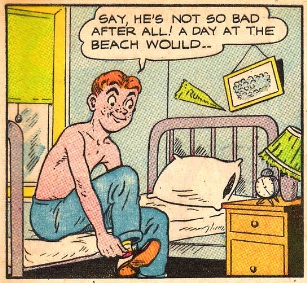In Zack and Miri Make a Porno (2008), the slacker buds(Seth Rogan, Elizabeth Banks) go to their 10-year high school reunion, where Miri aggressively propositions her old crush Bobby (Brandon Routh), without realizing that he is "gay now." Has he just, like, switched teams or something?
Bobby gets into an argument with his boyfriend, porn actor Brandon St. Randy (Justin Long). Zack looks on in amusement, commenting "They fight just like real people."
After that brief scene, the gay people disappear, but they give Zack the idea of making some money by producing a straight porn movie.

His friend Delaney (View Askew regular Craig Robinson) agrees to bankroll it, and Zack and Miri hire a ragtag band of amateurs to perform.
Such as Lester (Jason Mewes, the perennial Jay to Silent Bob), whose talent is getting aroused very quickly.
Yes, we do see his butt, his rather impressive penis, and his rather scrawny body.
The dimwitted Lester mistakenly believes that there will be gay sex in the film, and remarks "I'll make it with a guy if I have to, but I'd rather make it with a girl."
Delaney exclaims "What the hell is wrong with you?" in homophobic contempt. Obviously any guy who would do something as disgusting as engage in same-sex activity must have something wrong with them.
So according to Kevin Smith, gay people are mentally ill? Not a big revelation. Most of his movies make similar statements.
Later Lester demonstrates a way for two guys to have sex without doing anything gay.
They also hire Barry (Ricky Mabe), a chubby actor in young-adult theater. He doesn't mind being an anal bottom, as long as the top is a woman. In one scene his testicles are on display, probably (they could be a prop).
Deacon (View Askew regular Jeff Anderson) agrees to direct.
Naturally the group becomes a family, and work together to help Zack and Miri in their hour of need.
The porno is started but never finished. Instead, Zack and Miri fall in love.
I'll bet you didn't see that plot twist coming.
So, to sum up, the gay content consists of: two gay characters who vanish after the first ten minutes, three homophobic statements, Ricky Mabe's testicles, and Jason Mewes' penis.
Not a bad way to spend 90 minutes.






















































